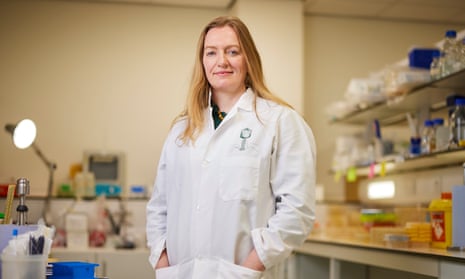The use of experimental therapies based on bacteria-killing viruses needs to be rapidly scaled up in the NHS to combat the worsening threat of antibiotic resistance, one of the UK’s leading scientists has said.
Prof Martha Clokie, who has pioneered research into bacteriophages, or phages, at the University of Leicester, said the approach was helping a growing number of patients in compassionate use cases, and could become a routine treatment in future for conditions such as chronic UTIs and diabetic foot ulcers.
Clokie will be the director of the UK’s first phage library, due to open at Leicester next month, which she says will help fast-track the use of phages in the NHS and pave the way for the large clinical trials required for phages to become licensed treatments.
“The risk from antibiotic resistance is dire and getting worse … I find it really shocking,” Clokie said. “Unless we have clinical trials, phages won’t become mainstream as a medicine, and that’s where we’re aiming.”
Phages work by infecting bacteria cells and killing them, but they are very specific in which infections they can target. They have been used successfully in a growing number of one-off cases, including a British teenager who was dying from an intractable lung infection and was treated at Great Ormond Street in 2019.
Q&AWhat are bacteriophages?
Show
Bacteriophages, or phages, are incredibly small viruses, just a few nanometres across. They are normally harmless to humans, but can be deadly for bacteria.
Phages work by penetrating the bacterial membrane and replicating inside the cell until it bursts open, killing the bacterium and releasing more phages. The key to harnessing them therapeutically is to find phages that are extremely efficient at killing the strains of bacteria causing particular infections.
In clinic, they can be inhaled through a nebuliser, sprayed on to the skin or taken orally, depending on the type of infection. To date, patients have typically been given bespoke therapies, but in future it is hoped that off-the-shelf cocktails of phages could be used to treat common infections, such as E coli and C difficile.
“I get fairly regular emails from doctors and patients wanting phages,” Clokie said. “Doctors have gone from being completely disinterested to ‘give me the phages now’ … There are people who need phages now because they’re dying.”
Clokie’s lab is preparing a phage cocktail for the doctor of a London-based patient with a chronic UTI, who is allergic to antibiotics and so does not have other treatment options. However, these one-off cases typically involve scientists spending months in the lab designing expensive, bespoke treatments.
“There’s always several months scrambling around trying to find the right phages,” she said. “The idea of having this systematic, well-curated collection is that … doctors will be able to access the right phages straight away.”

The lab already has a collection of about 2,000 phages stored in a freezer at -80C, and it hopes to increase this by about 1,000 samples each year. Phages occur ubiquitously in nature, but phage-hunting involves tracking down the ones that efficiently kill infection-causing strains.
“Wherever you have high numbers of bacteria, by definition you’ll have high numbers of phages,” Clokie said. “The most common place people look is human sewage.”
Clokie’s students have been sent out to dredge muddy estuaries and piles of horse muck in the quest for new species. A set of phages extracted from slime in a stream in Bradgate Park, Leicester, were found to be particularly good at targeting biofilms, which are often seen in chronic bladder infections and are among those under consideration for treating the London-based patient.
“It starts off incredibly low-tech,” Clokie said. But the advent of AI-based approaches means scientists are increasingly aiming to predict phage characteristics based on genetic sequencing, and how multiple phages might interact.
after newsletter promotion

Clokie said that despite a growing awareness of the threat of antibiotic resistance over the past decade, the outlook had not improved and doctors were reporting an expanding list of infections showing multi-drug resistance, including E coli, pneumonia, gonorrhoea and the stomach bug shigella.
A critical problem, she said, was the weak economic incentives for pharmaceutical companies to develop new antibiotics, given the increasingly restricted use of the drugs. In recent years, several companies have redirected R&D efforts into more lucrative areas such as cancer drugs, despite the growing threat of resistance.
“People will be cured of cancer but die of sepsis,” Clokie said. “There’s a really interesting disconnect between how much people are prepared to pay for drugs for autoimmune diseases or cancer and what they’re prepared to pay for antibiotics.”
Clokie is among those calling for an update to regulations created with conventional drugs in mind, to make it easier to carry out trials that could pave the way for wider use of phages. “At the moment, you need a willing doctor who is prepared to put phages into a patient as an unlicensed medicine and if something goes wrong they’ll get their licence removed,” she said.
In future, cocktails could be designed to treat common infections rather than specific strains in individual patients. Clokie said the growing use of phages in agriculture – as an alternative to chlorine spray in potato production – shows that costs are not prohibitive.
“They’re not going to replace antibiotics but they can be used to protect and preserve our antibiotics,” she said. “We can use them in chronic settings and we can use them in combination with antibiotics. I see it being a really useful complementary treatment.”
